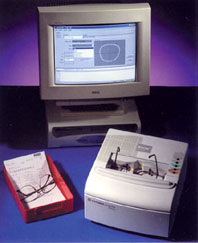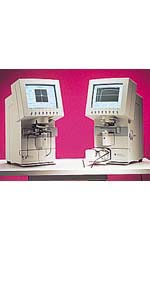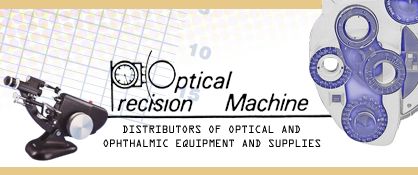|
Gerber Coburn
Kappa Patternless System |
Gerber Coburn Kappa SP is a computer-controlled, integrated lens
finishing system designed to grow with your business. It is a complete
system consisting of a tracing and blocking unit, and an automatic
patternless edger. The Kappa delivers a wide range of lens bevel and
groove options and offers unparalleled speed and accuracy.
The Kappa features the latest technology in frame tracing.
NEW, 4-D tracing software
provides the most precise frame tracing and lens mapping. The unique
4-D capability includes an exclusive frame groove measurement.
The enhanced software makes for easy lens processing, including finishing
of executive and small frame lenses. New, patented soft pin beveling
accommodates all lens sizes including small diameter lenses down to 24
millimeters. Automatic probing of the eye wire groove
profile ensures highly accurate sizes, decreases breakage and increases
quality.
Tracing, blocking and edging functions are fully-integrated. Digital
trace data is electronically transmitted from station to station as the
lens is processed, reducing errors. As production demand grows, up to five
Kappa or Gamma Edgers can be connected to a Kappa Tracer/Blocker,
increasing efficiency.
The Kappa automatically positions the stylus in the frame and traces
both eyes in less than 20 seconds, at the same time determining the frame
DBL. After tracing, the lens is placed in the blocker. A video camera
captures and displays an image of the lens, without parallax, along with
the frame shape. The operator aligns the lens and checks cutout. Block
application is motorized and fully automatic.
The Kappa has six automatic and controlled bevel options, as well as
lens grooving. In the Kappa Edger, probes map the contours of both
surfaces to determine lens curve, edge thickness and to calculate ideal
bevel or groove placement. Upon completion of lens mapping, a 3D
representation of the finished bevel or groove is shown on the screen,
allowing the user to view its position. Placement can be automatic or
modifications can be made.
Three groove widths are offered for improved fit. Kappa uses advanced
grooving design and computer control to precisely locate grooves on very
thin lenses. In addition, operators can probe the contour of the eye wire
groove. The probe records the profile of the eye wire groove and the Kappa
automatically adjusts the lens size. Measuring eye wire grooves eliminates
the practice of edging lenses oversized and re-edging them to fit.
The Kappa edges glass, CR39, hi-index and polycarbonate lenses. An
optional polishing wheel can impart a polished lens edge. The system
operates with a direct water hookup or a recirculating pump.
Wheel maintenance is automatic, reducing operator skill level. Using a
cleaning disk, Kappa controls the timing and pressure for consistent
results.
Kappa tracks productivity by lens material, bevel type, groove, edge
polish or error record. Sophisticated diagnostics monitor and test system
functions including mechanical movements and motors.
Fully-automatic controls, a user-friendly interface, and an ergonomic
design make the Kappa extremely easy to use. The full color display
highlights icons to indicate available options. Regardless of equipment
knowledge, an employee can be trained in the basic operation of the Kappa
in as little as an hour.

|
|
Gerber Coburn
Sigma Patternless |
Designed as an entry level patternless edging
system, Sigma is
simple, compact, and affordable. It employs 4-D processing
technology, traditional blocking functions, and a user-friendly
interface. And because Sigma is OMA compliant, it can interface
with a lab layout system such as Gerber Coburn's Innovations Edge
software. As a result, Sigma is ideal for first-time users
integrating finishing equipment into their practices.
Connect the Tracer to the Sigma Blocker and Edger to create a
complete, flexible edging system. The tracer's automatic clamping
mechanism and stylus insertion speed cycle times, and its' 4-D
tracing technology (x, y, z and frame groove angle) provides
precise frame measurements.
An integrated digital system provides a centralized operation
for accurately blocking lenses. Its low profile adds to the
overall small footprint, saving on valuable workspace.

Computer-generated lens-specific layout alignment targets help
to simplify the blocking process. Its unique color reversal
function makes it possible to visualize characteristics of
difficult lenses.
Sigma offers several methods of entering job information.
Operators can simply scan with a bar code wand and download job
specific parameters, preset customized setting, or manually select
settings. No matter how complex a job, Sigma's inherent
flexibility enables lenses to be processed accurately and quickly.

Sigma includes an essential lens mapping mechanism. Prior to
roughing, Sigma maps the lens, checks lens thickness and curve and
determines circumference. Sigma uses a special program for
checking executive lenses to ensure a perfect fit.
|
Bevel Options
Sigma offers four bevel options. With the automatic bevel
selection, Sigma calculates optimal bevel placement from the
furnished 4-D data, ensuring the best possible lens-to-frame fit.
More difficult or specialty lenses can be controlled using the
customized bevel options. Choices include: adjustable front curve,
33% or 50%, or flat edge.
NEW, patented soft pin beveling accommodates all lens sizes
including small diameter lenses down to 24 millimeters. The
soft pin beveling eliminates the need for any manual pin beveling,
reducing lens handling and decreasing the potential for spoilage
or breakage. With this new feature, control, consistency,
and quality are unparalleled.
NEW, grooving capability. Sigma's unique grooving
design and computer control precisely locates grooves, even on
very thin lenses. Plus, operators have a choice of setting
groove widths and depths in 0.05 mm increments.
The polishing option is available for plastic and polycarbonate
lenses only. Operators can activate by pressing a key.
Automatic maintenance functions-wheel cleaning, self
calibration, and a statistics and technical log enable the
operator to solve certain problems without technical assistance.
If telephone assistance is required, those functions provide
crucial information for effective troubleshooting.
Sigma's simple user interface features a customized toolbar,
intuitive icons, and color LCD screen for effortless operations.
Its large vertical keypad allows operators to easily monitor
various edging stages, even at a distance.

Automatic Tracing and Edging
Patternless
4-D Tracing
3-D Edging
|
Abrasive and Polishing Wheels
Multiple wheel configurations for
all materials or plastics dedicated
|
Bevel Options
Auto-bevel
Percentage
Customized on the front curve
Flat edge(rimless)
|
Lens Material Configurations
Plastic, polycarbonate, and glass
|
Lens Mapping
Consecutively records front and back lens contours
|
Sizing
Adjustable +8.00 to -8.00mm
|
|
|
|
115 V, single phase
60 Hz with ground, 15 AMP
|
|
|
Tracer 9 7/8" wide x 10 5/8" deep x 6 1/4" high ( 250 mm x
270 mm x 160 mm)
Edger 22" wide x 22" deep x 21"high (535mm x 560 mm x 515
mm)
|
|
|
|
|
|
Innovations™ Standard, Basic and Edge Software
|
|
|
|
|
253869-plastic/polycarbonate
|
|
|
|
|
|
Operation and Installation Manual
|
Posiblocks and adhesive pad kit
|
|
|
|
|
|
|
|
|
|
|
|
|
|
|
|
Direct water solenoid system P/N 220609
|
|
|
 |
|
Gerber Coburn
Envoy
Remote Frame Tracer |

The Envoy is a cost-effective remote frame tracer designed for
installation in satellite locations. Linked with compatible remote
data entry software, the Envoy sends digital trace data to the
processing laboratory via modem. The Envoy is fast, accurate and easy
to use and provides the same precise results as Gerber Coburn's in-lab
tracing systems.
The Envoy's 3-axis control captures 3,200 points (A and B, as well
as frame curve and elevation) for accurate 3-dimensional shapes. This
combination of measurements yields highly accurate sizing, decreases
breakage and increases quality during finishing. In addition, the
Envoy can trace both patterns and demo lenses for rimless frame
styles, by mounting them on a simple fixture. The Envoy sequentially
traces both eye wires during the trace cycle (operators may trace one
eye if desired). Frame DBL is automatically measured during tracing.
Designed for a satellite location, the Envoy has a small footprint
and an attractive appearance. Its compact size enables it to be
located adjacent to a computer running compatible remote order entry
software.
Envoy operation is easy and efficient, reducing operator error and
ensuring trace quality. After the frame is inserted, a simple frame
holding mechanism is clamped at the touch of a button. At the start of
a frame trace, the Envoy automatically inserts the stylus in the
eyewire and begins its precise tracing. Upon completion of the first
eyewire trace, the trace table shifts, the stylus is inserted again,
and the second eyewire is traced. The resulting digital trace data is
sent to the computer, and then to the lab via modem for use in surface
calculation and patternless edging.
Patterned after the production laboratory's Triumph Frame Tracer,
the Envoy's interface simplifies operation. Users can cycle through
the right, left or complete trace selection with a single key.
Training is minimal. Users can become proficient in Envoy operation in
under an hour. In addition, Envoy's advanced design increases
reliability and decreases maintenance, important considerations for
remote locations. Best of all Envoy is backed by Gerber Coburn's award
winning customer service and support.
Specifications
|
|
115 V AC, 50/60 Hz, single phase, 0.5 amps
|
|
|
9 7/8" w x 10 5/8" d x 6 1/4" h ( 250 mm x 270 mm x 160 mm)
|
|
|
|
|
|
Operation and installation manual
|
Calibration and diagnostic software(Windows 95 based)
|
Calibration and pattern/lens fixture
|
|

 Humphrey
Lens Analyzer Model 350 Humphrey
Lens Analyzer Model 350
Humphrey Lens
Analyzer 350 gives you fast, easy,
accurate lens neutralization for any lens: Progressive lenses,
prescriptions with prism, contact lenses, polycarbonate, or other
high-index materials without extensive training or reading through
thick manuals.
The LA 350 features an icon-based interface that guides the operator
through the neutralization process. They provide continuous feedback
and notify the user of special situations, such as lens aberrations or
rapid power changes. The instruments automatically calculate the
monocular and binocular spectacle PD without centering the lens. Just
place the lens in the instrument and it does the rest.

|
|

![]()
![]()
![]()

![]()
![]()
![]()